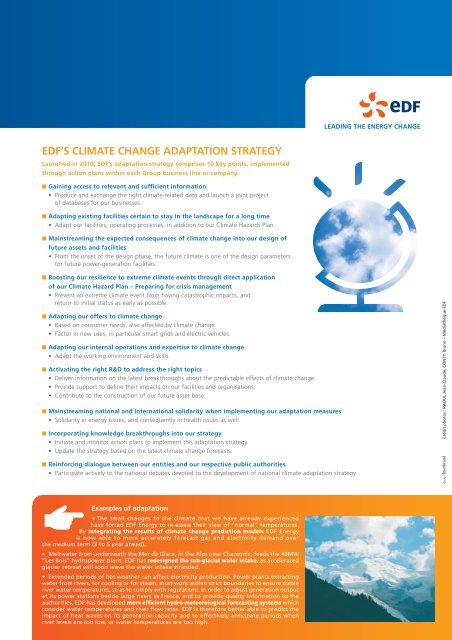Climate Action 2010-2011
You also want an ePaper? Increase the reach of your titles
YUMPU automatically turns print PDFs into web optimized ePapers that Google loves.
EDF’S CLIMATE CHANGE ADAPTATION STRATEGY<br />
Launched in <strong>2010</strong>, EDF’s adaptation strategy comprises 10 key points, implemented<br />
through action plans within each Group business line or company.<br />
■■Gaining access to relevant and sufficient information<br />
• Produce and exchange the right climate-related data and launch a joint project<br />
of databases for our businesses.<br />
■■Adapting existing facilities certain to stay in the landscape for a long time<br />
• Adapt our facilities, operating processes, in addition to our <strong>Climate</strong> Hazards Plan.<br />
■■Mainstreaming the expected consequences of climate change into our design of<br />
future assets and facilities<br />
• From the onset of the design phase, the future climate is one of the design parameters<br />
for future power-generation facilities.<br />
■■Boosting our resilience to extreme climate events through direct application<br />
of our <strong>Climate</strong> Hazard Plan – Preparing for crisis management<br />
• Prevent an extreme climate event from having catastrophic impacts, and<br />
return to initial status as early as possible.<br />
■■Adapting our offers to climate change<br />
• Based on consumer needs, also affected by climate change.<br />
• Factor in new uses, in particular smart grids and electric vehicles.<br />
■■Adapting our internal operations and expertise to climate change<br />
• Adapt the working environment and skills.<br />
■■Activating the right R&D to address the right topics<br />
• Deliver information on the latest breakthroughs about the predictable effects of climate change.<br />
• Provide support to define their impacts on our facilities and organisations.<br />
• Contribute to the construction of our future asset base.<br />
■■Mainstreaming national and international solidarity when implementing our adaptation measures<br />
• Solidarity in energy issues, and consequently in health issues as well.<br />
■■Incorporating knowledge breakthroughs into our strategy<br />
• Initiate and monitor action plans to implement this adaptation strategy.<br />
• Update the strategy based on the latest climate change forecasts.<br />
Crédit photos : RAOUL Jean-Claude, CONTY Bruno – Médiathèque EDF<br />
■■Reinforcing dialogue between our entities and our respective public authorities<br />
• Participate actively to the national debates devoted to the development of national climate adaptation strategy.<br />
design<br />
Examples of adaptation<br />
• The small changes to the climate that we have already experienced<br />
have forced EDF Energy to re-assess their view of “normal” temperatures.<br />
By integrating the results of climate change prediction models EDF Energy<br />
is now able to more accurately forecast gas and electricity demand over<br />
the medium term (3 to 5 year ahead).<br />
• Meltwater from underneath the Mer de Glace, in the Alps near Chamonix, feeds the 40MW<br />
“Les Bois” hydropower plant. EDF has redesigned the sub-glacial water intake, as accelerated<br />
glacier retreat will soon leave the water intake stranded.<br />
• Extended periods of hot weather can affect electricity production. Power plants extracting<br />
water from rivers, for cooling or for steam, must work within strict boundaries to ensure stable<br />
river water temperatures, so as to comply with regulations. In order to adjust generation output<br />
at its power stations beside large rivers in France, and to provide quality information to the<br />
authorities, EDF has developed more efficient hydro-meteorological forecasting systems which<br />
consider water temperatures and river flow rates. EDF is therefore better able to predict the<br />
impact of heat waves on its generation capacity and to effectively anticipate periods when<br />
river levels are too low, or water temperatures are too high.












